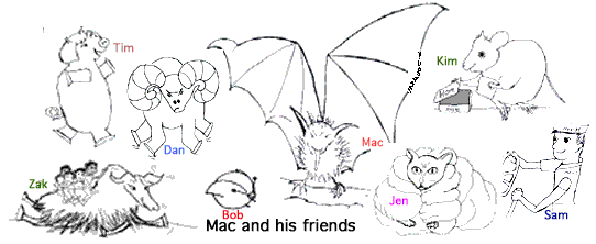

We hope you enjoy using these materials!
Research indicates that children who fall behind in reading haven't learned the alphabetic principle, the letter names, and the letter sounds by the beginning of first grade. This doesn't sound like much of a problem, but it is, because these students usually have very little SCHEMA for literacy (a schema is a network of information about a topic). The more schema one has, the easier it is to assimilate related material; therefore these children cannot assimilate new material relating to literacy as rapidly as is necessary to keep up in first grade. Teaching these children is often like throwing a velcro ball against a slick surface-it doesn't stick. It is possible to raise these children's awareness of literacy (build their schema) in KINDERGARTEN so that they are able to learn more on schedule in first grade, if we use a full range of activities and methods, while preserving motivation. Our approach is to make sure these children have success experiences every day and that nothing whatever embarrasses them. We carefully head off embarrassing moments; for example, if a child comes to a letter or word he/she doesn't know, we supply it before he or she even realize it (that's what so much fun about kindergartners--you can do that).
1.The first step is to teach the letters a, b, c, d, m, and t, using the "Mac the Bat" booklets and the activity sheets and games that go along with the booklets. Some of the games are Bingo, Letter Search, Matching, and Bang. The sentences in the booklets can be pasted to sentence strips and placed in a slip chart, then taken out again and again and replaced. Kids love this.
2. Students soon memorize the words in, "Mac the Bat"--Mac is a bat. Mac is bad. Or is Mac bad? Yes, Mac is a bad bat! Then, of course, they think they can read. It gets a little boring, but we continue to work with just a, b, c, d, m, and t and "Mac the Bat" through October and into November, until the children are getting bored too!
3. Toward the end of November we begin teaching the ALPHABETIC PRINCIPLE (we have already tried to get them to notice the final letters of, "bat" and, "bad"). We give students letter cards for b, a, and t and make the word, "bat". Later we add an m and have them race making the words, "bat" and, "mat". Then we add c and make "cat". Exposure does not result in all children understanding the alphabetic principle immediately, but does result in schema-building. They get the connection eventually, some sooner, some later (some much later).
4. All the booklets have exactly the same pattern, though the different characters do different things. Mac is a bad bat, because he sticks out his tongue and drops water balloons on Dan Junior. Dan is mad because Mac dropped a water balloon on his kid ("Dan the Ram" adds letters n and r). Tim likes to dance a jig and put on a wig ("Tim the Pig" adds letters p, j, g, and i). Sam is a man who delivers ham ("Sam the Man" adds letters h, s, and v). Kim is a rat that can get the ham ("Kim the Rat" adds letters k and l). Jen is a cat who gets wet ("Jen the Cat" adds the letter e). Zak is a yak that is fun but will sag ("Zak the Yak" adds letters f, u, y, and z). And Bob is a bug ("Bob the Bug" adds letters o). All the letters of the alphabet are presented except for X and Q. Each letter has a memorable (hopefully) word associated with it.
5. After a month or two (or three) spent on Mac the Bat, we begin presenting the other booklets rapidly, usually a booklet a week. The children eagerly anticipate each new book. When the booklets have all been read at school we send home a packet of all eight; we have found that sending them home one at a time results in their being misplaced--the whole set seems to have a better chance. We are able to afford to send home booklets for each child because we make the booklets from two sheets of legal paper and a booklet stapler!
6. After all the booklets have been presented, they are read and reread in the small groups. A rack displays the booklets and each day every child picks one to read. Each child gets to pass out the booklets to their classmates and then reads the whole book. They then collect the booklets and put them back. Children who have been discipline problems will kill to get to "read" a whole book at this point. It is a joy to see the little darlings carefully placing a booklet in front of each classmate and then slowly, slowly opening their booklet and reading it. Reading truly civilizes all of us.
7. This year we had finished and sent home the set of eight "Mac the Bat" series by February. In March we started reading, "Biscuit". This is a great series for early readers--in the first book, "Biscuit", all the children read, "Woof, woof!" together on virtually every page. In the second Biscuit book, "Biscuit Finds a Friend", Biscuit has a duck for a friend and the children all read both, "Woof!" and "Quack!" together. It's hilarious.
Toward the end of the year we read "The Hurt Puppy" and "My Mother Has a Cold" from the first grade set of booklets. Only an occasional student does not know the sounds and letters by the end of the year, and most can read at least on a DRA level 3.